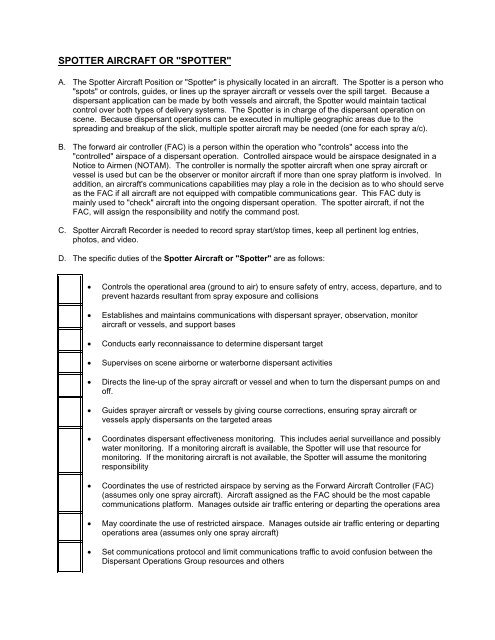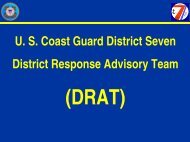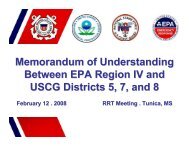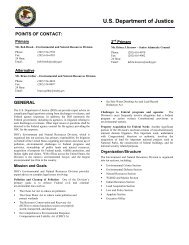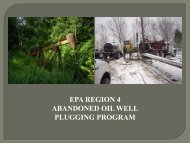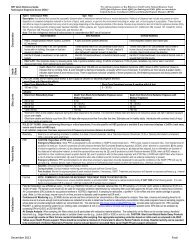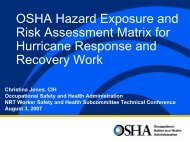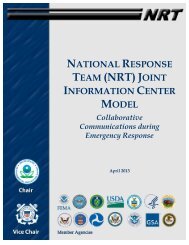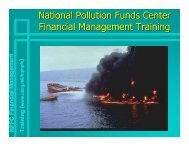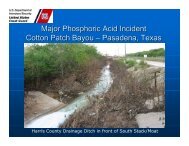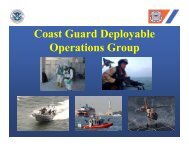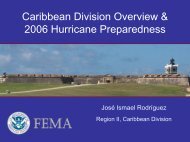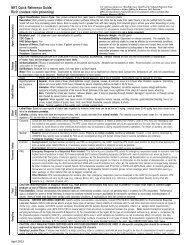USE OF DISPERSANTS - U.S. National Response Team (NRT)
USE OF DISPERSANTS - U.S. National Response Team (NRT)
USE OF DISPERSANTS - U.S. National Response Team (NRT)
- No tags were found...
Create successful ePaper yourself
Turn your PDF publications into a flip-book with our unique Google optimized e-Paper software.
SPOTTER AIRCRAFT OR "SPOTTER"A. The Spotter Aircraft Position or "Spotter" is physically located in an aircraft. The Spotter is a person who"spots" or controls, guides, or lines up the sprayer aircraft or vessels over the spill target. Because adispersant application can be made by both vessels and aircraft, the Spotter would maintain tacticalcontrol over both types of delivery systems. The Spotter is in charge of the dispersant operation onscene. Because dispersant operations can be executed in multiple geographic areas due to thespreading and breakup of the slick, multiple spotter aircraft may be needed (one for each spray a/c).B. The forward air controller (FAC) is a person within the operation who "controls" access into the"controlled" airspace of a dispersant operation. Controlled airspace would be airspace designated in aNotice to Airmen (NOTAM). The controller is normally the spotter aircraft when one spray aircraft orvessel is used but can be the observer or monitor aircraft if more than one spray platform is involved. Inaddition, an aircraft's communications capabilities may play a role in the decision as to who should serveas the FAC if all aircraft are not equipped with compatible communications gear. This FAC duty ismainly used to "check" aircraft into the ongoing dispersant operation. The spotter aircraft, if not theFAC, will assign the responsibility and notify the command post.C. Spotter Aircraft Recorder is needed to record spray start/stop times, keep all pertinent log entries,photos, and video.D. The specific duties of the Spotter Aircraft or "Spotter" are as follows:• Controls the operational area (ground to air) to ensure safety of entry, access, departure, and toprevent hazards resultant from spray exposure and collisions• Establishes and maintains communications with dispersant sprayer, observation, monitoraircraft or vessels, and support bases• Conducts early reconnaissance to determine dispersant target• Supervises on scene airborne or waterborne dispersant activities• Directs the line-up of the spray aircraft or vessel and when to turn the dispersant pumps on andoff.• Guides sprayer aircraft or vessels by giving course corrections, ensuring spray aircraft orvessels apply dispersants on the targeted areas• Coordinates dispersant effectiveness monitoring. This includes aerial surveillance and possiblywater monitoring. If a monitoring aircraft is available, the Spotter will use that resource formonitoring. If the monitoring aircraft is not available, the Spotter will assume the monitoringresponsibility• Coordinates the use of restricted airspace by serving as the Forward Aircraft Controller (FAC)(assumes only one spray aircraft). Aircraft assigned as the FAC should be the most capablecommunications platform. Manages outside air traffic entering or departing the operations area• May coordinate the use of restricted airspace. Manages outside air traffic entering or departingoperations area (assumes only one spray aircraft)• Set communications protocol and limit communications traffic to avoid confusion between theDispersant Operations Group resources and others


